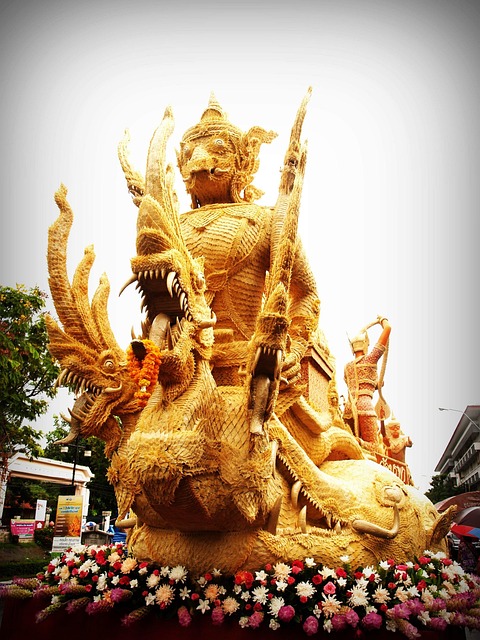Festival Overview: Key Facts at a Glance
Every July, the city of Ubon Ratchathani in northeastern Thailand transforms into a colorful celebration of faith and craftsmanship. The Ubon Ratchathani Candle Festival brings communities together in a joyful tribute to Buddhist traditions, with wax sculptures and ceremonies that light up the streets and hearts of all who attend.
-
-
- Event: A cultural and religious celebration centered on wax art and Buddhist rituals.
- Place: Ubon Ratchathani, located in Thailand’s Isan region.
-
- Time: Each July, with specific dates based on the lunar calendar.
- Religious meaning: Honors Asalha Bucha and begins the Buddhist Lent period known as Vassa.
- Highlights: Giant wax sculptures, floats, and processions with music and traditional costumes.
- Economic role: Supports tourism and showcases regional arts.
- Artistic value: Celebrates Thai mythology and Buddhist themes through detailed carving.
- Contributors: Local artisans, monks, youth groups, and international guests.
1. The Festival’s Spiritual Meaning
Honoring Buddhist milestones
This festival marks two important days in the Buddhist calendar. The first is Asalha Bucha, when the Buddha gave his first sermon. Earlier in the calendar, Visakha Bucha is celebrated to honor the Buddha’s birth, enlightenment, and passing — three key moments in Buddhist history. The second is Wan Khao Phansa, the day when monks begin a seasonal retreat for reflection and study known as Vassa.
Symbolism of the candles
In earlier times, candles were offered so monks could continue their spiritual practices after nightfall. Today, these offerings have taken the form of elaborate candle sculptures, symbolizing the light of wisdom and the path to inner peace.
2. Sculpting Wax into Stories

From practical gifts to epic creations
What used to be simple candles has evolved into elaborate wax statues. Many depict stories from sacred texts, mythical animals, or royal history. These floats become visual narratives, moving through the city to tell age-old tales in a new way.
Materials and methods
Beeswax forms the base of most sculptures. Artists heat and shape it layer by layer using knives, molds, and handmade tools. Some structures stretch several meters long and are months in the making.
Community effort
These creations aren’t made by individuals alone. Schools, temples, and neighborhood teams work side by side. Some invite artists from other countries, creating a unique blend of techniques and interpretations.
3. Events and Celebration
Preview evening at the park
Before the parade, floats are placed in Thung Si Mueang Park for public viewing. At night, they’re lit and accompanied by dance, music, and storytelling performances — giving a first glimpse of the celebration to come.
Parade through the streets
On the main day, each float is moved through the city, surrounded by dancers, musicians, and representatives from local communities. It’s a mix of ceremony and festival, where spiritual purpose meets public joy.
4. Local Culture and Flavors
Street food and seasonal treats
The aroma of grilled meats, fresh som tam, and coconut desserts fills the air. You’ll also spot stalls offering Pad Thai, and in July, seasonal fruits like durian and mangosteen are everywhere.
New to Thai cuisine? Use this easy guide to ordering in local markets and street stalls.
Workshops and crafts
Want to do more than watch? Several locations, including Ban Khampun, run workshops where you can try your hand at candle carving or traditional weaving.
Other wax traditions in Thailand
Ubon’s isn’t the only wax festival. Similar events occur in:
- Ladchado: Floating candle parades on canals.
- Nakhon Phanom: River-based celebrations inspired by Lao customs.
- Nakhon Ratchasima: Blending modern sculpture with heritage themes.
5. Planning Your Visit
When to attend
In 2024, the Ubon Ratchathani Candle Festival took place from July 13–21. For 2025, it’s expected between July 7–13. The parade usually happens over the weekend, drawing the largest crowds. As the festival occurs during Thailand’s rainy season, visitors should come prepared for occasional showers — but don’t worry, the festivities go on rain or shine!
Getting there
You can reach Ubon Ratchathani by plane (about 1h15 from Bangkok), by train, or by long-distance bus. Transport options in the city include tuk-tuks, taxis, and songthaews — shared pickups used as local buses.
Helpful tips
- Book accommodation early, especially if you want to be near the city center.
- Dress modestly and comfortably; you’ll be walking a lot and visiting temples.
- Weather is unpredictable — bring both sunscreen and a rain poncho.
- Respect performers and artisans; ask politely before taking close-up photos.
6. Why the Festival Matters
A shared achievement
Each float tells a story, but also reflects the teamwork and dedication of entire communities. Whether they win awards or not, the experience of creating together is priceless for many locals.
Preserving living traditions
The festival keeps ancient skills alive — from wax molding to traditional dancing. It’s officially part of Thailand’s cultural heritage, and plays a big role in passing knowledge to the younger generation.
7. Conclusion

A celebration that leaves a mark
The Ubon Ratchathani Candle Festival is not just about beautiful floats. It’s about light in every sense — spiritual, artistic, and communal. For those who witness it, the experience is unforgettable.
🔄 Last updated on July 8, 2025
